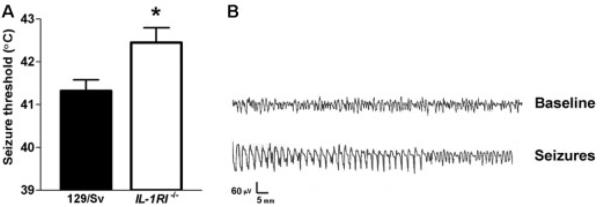Fig 1.
(A) Mice deficient in the interleukin-1 receptor (IL-1R1−/−) are more resistant to the generation of experimental febrile seizures (FSs) compared with wild-type control mice of a similar genetic background (129/Sv). Threshold temperatures for the onset of these seizures, a reliable measure of susceptibility,12 were significantly greater in IL-1R1−/− mice: 42.4 ± 0.3°C versus 41.3 ± 0.2°C in wild-type mice. (See Materials and Methods for details of IL-1R1−/− mice generation and background.) (B) Hippocampal electroencephalogram recordings from unanesthetized wild-type mouse. Normal θ rhythm is evident, which is attenuated by progressive hyperthermia and is replaced by epileptiform discharges. The behavioral correlates of the electroencephalogram seizure consist of sudden immobility associated with reduced response to stimulation (“altered consciousness”), which is typically associated with limbic automatisms. * indicates p < 0.05

